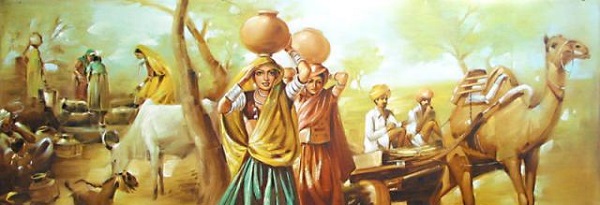
What are Thaats?
In simple words, Thaats are a way to classify various ragas into groups based on which Swaras are used in a specific Raag. When thinking about it you might think that Thaats and Ragas were created at the same time but contrary to the intuition, the Ragas existed long before the Thaats and later Thaats were created to classify the Ragas.
The question now you can ask, then who created Thaats? Well, Thaats were created by a musicologist name Vishnu Narayan Bhatkhande (1860-1936) and his first ideas were inspired by the Mela System of Carnatic Music from South India. The Mela System or more fully, a Swaramela System represents a group or collection of Swaras which are compatible with each other in the pitches so that when sung together they sound wonderful.
Properties of Thaats
A Classification System for Ragas:
Since Thaats are not actually Ragas but rather they are a classification system, obviously, they are not supposed to be sung by a singer. It is like in a school, if the students are represented by class VI and class VII, then these classes are not supposed to be taught by a teacher, instead, it is the students who are taught by the teacher. Or another example can be, if we make a house based on the blueprint then we don’t live in a blueprint but we live in a house. (Hope it is clear). Thaats are also represented by “Mode” which is nothing but a specific scale in Hindustani Classical Music.
Thaats always have 7 Notes (Pitches):
Let us not forget that in Indian Classical Music notes of an octave have names like this:
Sa Re Ga Ma Pa Dha Ni SA
I will use the notation for notes like this:
Komal Swara (flat notes): All small caps
Tivra Swara (sharp): Swara+
Now of course there are some Komal and Tivra version of these Swaras which are represented as follows:
- Flat Re: re
- Flat Ga: ga
- Flat: Dha: dha
- Flat Ni: ni
- Tivra Ma, Ma+
So now including these variations of Swaras we have in total 12 Swaras like this:
Sa, (re Re), (ga Ga), (Ma Ma+) Pa (dha Dha) (ni Ni)
Having these 12 notes, any combination of 7 notes out of 12 notes will represent a Thaat if it follows the following rule:
RULE: Any parent scale can have just one note from the following pairs (re, Re), (ga, Ga), (dha, Dha), and (ni, Ni).
So now if we do some Maths then we have the following possibilities:
1 x 2 x 2 x 2 x 1 x 2 x 2 = 32
This number 32 represents a total number of Thaats which were initially proposed by Bhatkhande. But later, he decided to only have 10 main Thaats which cover almost all the Ragas and hence today we only learn about 10 Thaats by their names.
Thaats have only Aroh Sequence:
I think this is very clearly understood that since Thaats are not supposed to be sung, they only have Aroh sequence.
Both Version (Note and Semintone) of a Swara is Not Allowed:
Although we have ga and Ga or Ma and Ma+, but in any Thaat, both versions of the Swara are not allowed. Now if you pay attention, you will notice a pattern that this rule actually removes the possibility of having Swaras which are half tone (semitone) apart. Which is a stricter rule than generally found in Mela System.
For example, an acceptable classification for Mela System like this
Sa re Re Ma+ Pa dha Dha SA
is completely not accepted in Hindustani Classical Music as it contains notes which are half note apart (Violation is marked as bold). Also, it violates the rule define before.
Which Ragas belong to which thaats (Examples).
The main 10 (and not 32) Thaats which were proposed by Bhatkhande are named after the most popular Raag which belongs to it. Here are the 10 Thaats and some Ragas which belong to it.
Bilawal (Ionian mode): Sa Re Ga ma Pa Dha Ni SA
Morning: Raag Alhaiya Bilawal, Raag Bilawal
Evening: Raag Durga
Night: Raag Bihag, Raag Hamsadhwani
Khamaj (Mixolydian mode): Sa Re Ga ma Pa Dha ni SA
Evening: Raag Desh, Raag Khamaj
Night: Raag Gorakh Kalyan, Raag Champakali, Raag Jog, Raag Rageshree, Raag Saraswati, Raag Tilak Kamod
Kafi (Dorian mode): Sa Re ga ma Pa Dha ni SA
Morning: Raag Asavari, Raag Jaunpuri
Afternoon: Bhimpalasi
Evening: Raag Kafi, Raag Patdeep
Night: Raag Bageshree, Raag Chandrakauns, Raag Pilu, Raag Shivranjini
Asavari (Aeolian mode): Sa Re ga ma Pa dha ni SA
Morning Raag Asavari, Raag Jaunpuri
Night: Raag Adana, Raag Darbari
Bhairavi (Phrygian mode): Sa re ga ma Pa dha ni SA
Morning: Raag Bhairavi, Raag Komal Rishabh Asavari
Night: Raag Malkauns
Bhairav (double harmonic): Sa re Ga ma Pa dha Ni SA
Morning: Raag Ahir Bhairav, Raag Bairag, Raag Bhairav, Raag Jogiya, Raag Nat Bhairav, Raag Ramkali
Kalyan (Lydian mode): Sa Re Ga Ma Pa Dha Ni SA
Afternoon: Raag Shudh Sarang
Evening: Raag Bhopali, Raag Meru Bihag, Raag Yaman
Night: Raag Kedar
Marwa Sa re Ga Ma Pa Dha Ni SA
Dawn: Raag Bhatiyar, Raag Sohini
Evening: Raag Puriya Kalyan
Poorvi Sa re Ga Ma Pa dha Ni SA
Dawn: Raag Lalit
Afternoon: Raag Poorvi
Evening: Raag Puriya Dhanashree
Todi Sa re ga Ma Pa dha Ni SA
Morning: Gujari Todi
Afternoon: Raag Madhuvanti, Raag Multan